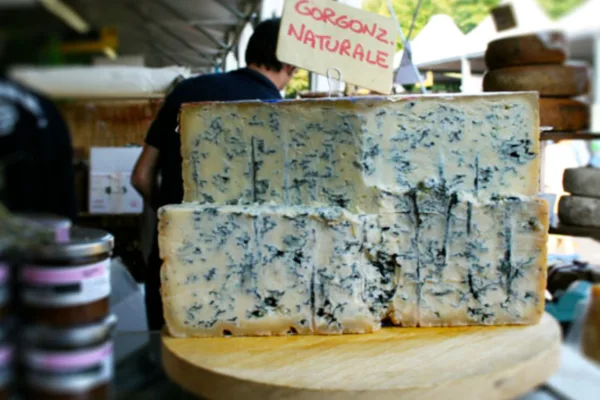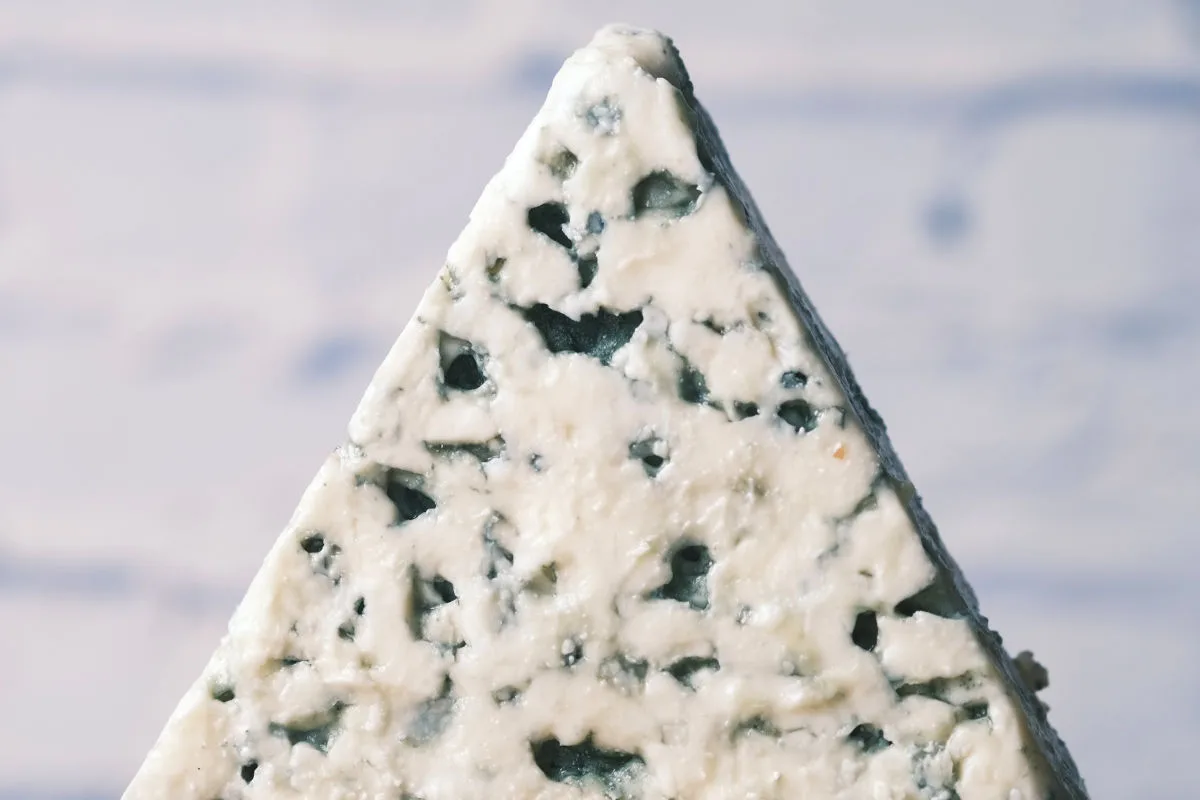Gorgonzola is an Italian blue cheese made from cow’s milk and comes with a pungent, tangy flavor. There are two main types of Gorgonzola cheese: Gorgonzola Piccante, and Gorgonzola Dolce. In this article, we discover what Gorgonzola cheese is, how to use it in recipes, purchasing and storage tips, and where to buy the best Gorgonzola cheese.
Table of Contents:
What is Gorgonzola?
Gorgonzola is considered to be one of the world’s oldest veined Italian blue cheeses and carries the PDO (Protected Designation of Origin) status. It is made from unskimmed cow’s milk and is renowned for its pungent, tangy flavor. It is named after the town of Gorgonzola in the Lombardy region of northern Italy, where it was first produced.
The cheese is made from cow’s milk and is aged for several months, during which time it develops its characteristic blue mold. This mold gives Gorgonzola its tangy and pungent flavor, as well as its crumbly or creamy texture, depending on the variety. It can be buttery or firm, crumbly, and quite salty, with a characteristic bite from its blue veining.
There are two main types of Gorgonzola:
- Gorgonzola Dolce:
This is the milder and creamier version of Gorgonzola. It has a sweeter and less intense flavor due to its shorter aging period. Gorgonzola Dolce is often used in salads, pasta dishes, or as a spread on bread and crackers.
- Gorgonzola Piccante:
This is the stronger and more aged version of Gorgonzola. It has a sharper, more intense flavor with a crumbly texture. Gorgonzola Piccante is often used in sauces for pasta, risotto, or as a topping for steaks and burgers.
Recipes with Gorgonzola
Gorgonzola cheese is a popular ingredient in Italian cuisine and is used in a variety of dishes to add depth and richness of flavor. It can also be enjoyed on its own or paired with fruits, nuts, and wine as part of a cheese platter (yes please!).
Some recipes that feature Gorgonzola include:
- Gorgonzola and Pear Salad with a balsamic glaze
- Gorgonzola and Mushroom Risotto
- Gorgonzola-Stuffed Chicken Breasts
- Gorgonzola and Walnut Pasta
- Gorgonzola and Caramelized Onion Flatbread
- Gorgonzola and Walnut Quiche
- Gorgonzola and Bacon-Stuffed Dates
- Gorgonzola and Pear Pizza
- Gorgonzola and Spinach Stuffed Mushrooms
- Gorgonzola and Fig Crostini

How to Serve Gorgonzola Cheese
Gorgonzola cheese is versatile and can be served in various ways, depending on your preferences and the occasion.
When serving Gorgonzola cheese, consider the two main varieties: Gorgonzola Dolce and Gorgonzola Piccante. Gorgonzola is a bold cheese, so a little goes a long way in terms of flavor.
Here are some common and delicious ways to serve Gorgonzola cheese:
1. Cheese Platter:
– Arrange Gorgonzola cheese on a cheese platter alongside other cheeses, such as brie, cheddar, and gouda.
– Add accompaniments like crackers, sliced baguette, fresh and dried fruits (grapes, figs, apples), nuts (walnuts, almonds), and honey.
– Serve with a selection of wines, such as red wine, port, or a sweet dessert wine.
2. Salad Topping:
– Crumble Gorgonzola cheese over salads for a burst of flavor. It pairs particularly well with mixed greens, pears, apples, walnuts, and balsamic vinaigrette dressing.
– You can also use Gorgonzola in a classic Waldorf salad or in a spinach and bacon salad.
3. Pasta Sauce:
– Use Gorgonzola cheese in pasta sauces for a creamy and savory flavor, think Gorgonzola and walnut pasta or in a creamy mushroom pasta.
4. With Meats:
– Use Gorgonzola cheese as a stuffing or melt it onto meats like chicken breasts, pork chops, or beef tenderloin.
5. Pizza Topping:
– Crumbled Gorgonzola cheese is amazing as a topping for pizza, and will add a unique and tangy dimension to your favorite pizza recipes. It pairs wonderfully with pears, figs, or prosciutto.
6. Appetizers:
– Stuff dates or mushrooms with Gorgonzola cheese, wrap them in bacon, and bake for a delicious appetizer.
– Create Gorgonzola and pear crostini or serve Gorgonzola-stuffed cherry tomatoes for bite-sized treats.
7. Sandwiches and Wraps:
– Spread Gorgonzola cheese on sandwiches and wraps. You’ll find it goes well with many ingredients from vegetables to meats.
8. Gourmet Burgers:
– Top burgers with crumbled Gorgonzola cheese for a gourmet twist on a classic favorite. Add caramelized onions or bacon for extra flavor. And if you’ve never tried slices of beetroot on a burger, we highly recommend that, too!
9. Soups:
– Use Gorgonzola cheese to garnish creamy soups like potato leek or butternut squash for a creamy, tangy contrast.
10. Desserts:
– While less common, some dessert recipes incorporate Gorgonzola cheese in cheesecakes or as a garnish for sweet dishes like poached pears drizzled with honey.
As you can see, Gorgonzola can jazz up just about any type of recipe.

Where Can I Buy Gorgonzola Cheese?
Buying Gorgonzola in the USA
The cost of Gorgonzola cheese in the USA can vary widely depending on several factors, including the brand, the type of Gorgonzola (Dolce or Piccante), the region or store where you purchase it, and whether it’s pre-packaged or sold from the cheese counter.
- Walmart sells a variety of Gorgonzola products.
- Supermarket Italy stocks Gorgonzola and many other Italian products.
Buying Gorgonzola in Europe
Many, maybe even most, continental European countries will have Gorgonzola stocked in at least one brand of local supermarket. Lidl is always a good bet for Gorgonzola too, if there’s one near you. Otherwise, there are plenty of online stores like Italy Bite that will ship to countries in Europe.
Buying Gorgonzola in the UK
You’ll have no trouble finding Gorgonzola in the UK either. Tescos, Sainsbury’s, Lidl, and all the big supermarkets have at least one packet. You can also order some online from a site like Gastronomica.
Purchasing Tips for Gorgonzola Cheese
Not all brands of Gorgonzola cheese are labeled with the Protected Designation of Origin (PDO) status.
To be labeled as “Gorgonzola” with PDO status, the cheese must meet specific criteria and be produced in the designated region of Italy, which includes parts of the Lombardy and Piedmont regions. The PDO status ensures that the cheese is made according to traditional methods and from specific milk sources in this region.
However, there are Gorgonzola-style blue cheeses made in other parts of the world and by different producers that do not have the PDO status. These cheeses may be labeled as “blue cheese” or “blue Roquefort” but cannot carry the name “Gorgonzola” with the PDO designation unless they meet the specific requirements outlined by the EU.
When purchasing Gorgonzola cheese, if you want authentic Italian PDO Gorgonzola, look for packaging that explicitly mentions the PDO status or states that it is a product of Italy and follows traditional production methods.
Gorgonzola Storage to Maintain Quality
Gorgonzola cheese should be stored in the refrigerator. The ideal temperature for storing Gorgonzola is around 35-45°F (1-7°C). Use the vegetable crisper or a cheese storage container if available, as these areas tend to have more stable humidity levels.
Allow some airflow around the cheese. If the cheese comes in a resealable package, keep it partially open or loosely wrap it in wax paper or parchment paper. This allows the cheese to breathe and prevents excess moisture buildup, which can lead to mold growth.
If storing multiple types of cheese, try to keep them separated to prevent the flavors from blending. By following these storage guidelines, you can prolong the shelf life of your Gorgonzola cheese and enjoy it at its best quality.
Can You Freeze Gorgonzola Cheese?
It is not recommended to freeze Gorgonzola cheese because freezing can ruin its texture and flavor. Gorgonzola is a soft and creamy cheese, and freezing and thawing can cause it to lose some of its original characteristics. Not to mention freezing can lead to the separation of moisture from the cheese, resulting in a less desirable texture.
Nutrition Facts
Gorgonzola cheese is a rich and flavorful cheese, but it’s also high in fat and calories. Here are the approximate nutrition facts for Gorgonzola cheese per 1-ounce (28-gram) serving:
– Calories: Approximately 100-110 calories
– Protein: Approximately 6-7 grams
– Total Fat: Approximately 8-9 grams
– Saturated Fat: Approximately 5-6 grams
– Monounsaturated Fat: Approximately 2 grams
– Polyunsaturated Fat: Less than 1 gram
– Cholesterol: Approximately 20-25 milligrams
– Carbohydrates: Less than 1 gram
– Dietary Fiber: 0 grams
– Sugars: 0 grams
– Sodium: Approximately 300-400 milligrams
Of course, these values will vary based on the brand and variety of Gorgonzola cheese. The moral of the story is: Yes, Gorgonzola is unbelievably tasty and can go with just about everything, but we probably shouldn’t eat a block a day. In moderation, it’s absolutely fine though.
While Gorgonzola cheese can be a delicious addition to many dishes, it’s important to consume it in moderation, especially if you are watching your calorie or saturated fat intake, as well as sodium. Additionally, Gorgonzola cheese isn’t suitable for individuals who are lactose intolerant.
Cheeses Similar to Gorgonzola
If you’re looking for cheeses that are similar in flavor and texture to Gorgonzola, you can explore other blue cheeses from around the world. Here are some blue cheeses that share similarities with Gorgonzola:
- Roquefort cheese is a famous blue cheese used extensively in French cuisine, made from sheep’s milk. It has a creamy texture and a sharp, tangy flavor with distinct blue veins and a pungent aroma. It comes from the small village of Roquefort and is made from ewe’s milk.
- Stilton cheese is a British blue cheese made from cow’s milk. It has a crumbly and creamy texture, similar to Gorgonzola, and a rich, robust flavor with blue veining. Stilton is often characterized by its mellow and earthy taste.
- Danish Blue cheese is a creamy blue cheese from Denmark, typically made from cow’s milk. It has a smooth and creamy texture with a mild to moderately strong blue cheese flavor. It’s often less intense than Gorgonzola Piccante.
- Bleu d’Auvergne is a French blue cheese made from cow’s milk. It has a creamy texture and a strong, tangy flavor with blue veins. It is similar in flavor and texture to Roquefort but tends to be milder.
- Cambozola is a German blue cheese that combines the characteristics of Camembert and Gorgonzola. It has a creamy and soft texture with blue veining and a mild, buttery flavor. It’s a good introduction to blue cheeses if you’re new to them.
- Fourme d’Ambert is another French blue cheese made from cow’s milk. It has a semi-soft, creamy texture and a milder blue cheese flavor compared to some other blue cheeses.
While these cheeses share similarities with Gorgonzola, each has its unique characteristics and flavor profiles. Remember, there can only be one true Gorgonzola.


Leave a Reply